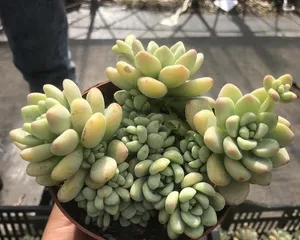Succulents are very popular indoor potted plants, but their growth and care in the summer also require our attention and management. In high-temperature, rainy, and humid environments, succulents are prone to problems such as excessive heat, high humidity, and insufficient light, which in turn leads to the breeding of pests and diseases and slowed growth. This article will introduce summer care methods for succulents to help them get through a safe and healthy summer.

Choose the Right Summer Care Location
When caring for succulent plants in the summer, choose a location that is bright, well-ventilated, and avoids direct sunlight, maintaining suitable temperature and humidity. Especially during midday and afternoon, try to avoid direct sunlight exposure, as it can easily cause the leaves to become dry, scorched, and aged.
Pay Attention to Water Control
In the summer, succulent plants need a moderate amount of water to maintain growth and care. However, overwatering can lead to root rot and plant decay, affecting the growth and health of the succulent. During summer care, pay attention to water control and management, increase the frequency of watering appropriately, and reduce the amount of water per watering to prevent excess water from accumulating and attracting pests and diseases.

Adjust Light Reasonably
Succulent plants love light, but the hot, dry summer has a significant impact on them. We need to adjust the light reasonably, providing a moderate amount of light in the morning and evening, and avoiding harsh midday sun. At the same time, if you find that your succulent is growing slowly in the summer, you can consider increasing the light intensity or installing a shade cover.
Avoid High Temperatures
In hot summer weather, succulent plants are easily damaged, showing signs like leaf curling and wilting. During high temperatures, we need to choose a well-ventilated, shaded, and cool location, or use measures like shade nets or covers to lower the indoor temperature, preventing the succulent from losing water due to excessive transpiration.
Fertilize Appropriately
During summer care, proper fertilization can provide the necessary nutrients for succulent plants, promoting their growth and health. However, when fertilizing, be mindful to use it in moderation and avoid over-fertilizing. Generally, fertilize once every 10-15 days. You can use a fertilizer specifically for succulents, controlling the amount to 1/3 to 1/2 of the usual dosage.

Pay Attention to Pest and Disease Control
In the hot and humid summer environment, succulent plants are susceptible to pests and diseases such as aphids, whiteflies, and spider mites. During the care process, strengthen the observation and inspection of your succulents, detect pest and disease problems in a timely manner, and take corresponding preventive and control measures, such as spraying insecticides or increasing ventilation.
Regularly Clean Up Fallen Leaves
During the summer growing season, the leaves and stems of succulent plants may wither and fall off. Regularly cleaning up fallen leaves and dead branches can prevent the breeding of bacteria and pests, maintaining the health of the succulent plant.
Choose the Right Potting Soil
Succulent plants need well-aerated and well-draining potting soil to maintain their growth and health. During summer care, we should choose potting soil suitable for succulent growth and master the frequency and amount of watering to prevent waterlogging in the roots, which can lead to root rot.
Control Humidity Reasonably
In the humid summer environment, succulent plants are prone to excessively high humidity, which can in turn lead to problems like root rot and soft, drooping stems. During summer care, we should pay attention to controlling indoor humidity, maintain good ventilation, and reduce the amount and frequency of watering to prevent excess water from accumulating.
Regular Pruning and Trimming
During summer care, we should regularly prune and trim succulent plants, removing old, withered, or severely diseased leaves and branches to promote new growth and a healthy state.
Pay Attention to Temperature Changes
In the summer, there is a large temperature difference between indoors and outdoors, and succulent plants are easily affected by these changes, leading to slow growth or the appearance of pests and diseases. During the care process, we should pay attention to the temperature changes and adjust the indoor temperature and humidity in a timely manner to prevent the succulent plants from being affected.
Increase Ventilation Appropriately
In summer care, appropriate ventilation can promote the growth and health of succulent plants. Especially in hot, humid weather, ventilation can increase indoor air circulation, reduce the accumulation of water vapor and carbon dioxide, and prevent problems like root rot in succulent plants.
Adjust Humidity Reasonably
In summer care, adjusting humidity reasonably can promote the growth and health of succulent plants. We can use a sprayer to moderately increase indoor humidity, or place a hygrometer to monitor humidity changes and adjust care measures in a timely manner.
Regularly Replace Soil
When succulent plants grow rapidly in the summer, their roots may outgrow the original potting soil, leading to problems like nutrient deficiency and slow growth. During summer care, we should regularly replace the potting soil and prune the roots in a timely manner to maintain the health and growth of the succulent plant.
Summer is a crucial period for the growth and care of succulent plants. We need to pay attention to their location, water, light, temperature, and humidity to prevent problems like pests and diseases. By following the methods introduced in this article, I believe everyone can help their succulents get through a safe and healthy summer.